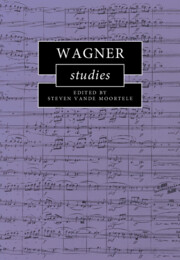Book contents
- Wagner Studies
- Cambridge Composer Studies
- Wagner Studies
- Copyright page
- Contents
- Figures
- Tables
- Music Examples
- Notes on Contributors
- Introduction: Analysing Wagner
- Part I Orientations
- Part II Form, Drama and Convention
- Part III Time, Texture and Tonality
- Part IV Reception
- 9 Silence and Gesture in Mahler’s Ninth Symphony and Wagner’s Parsifal
- 10 Wagner’s Early Analysts
- Bibliography
- Index
10 - Wagner’s Early Analysts
from Part IV - Reception
Published online by Cambridge University Press: 17 April 2025
- Wagner Studies
- Cambridge Composer Studies
- Wagner Studies
- Copyright page
- Contents
- Figures
- Tables
- Music Examples
- Notes on Contributors
- Introduction: Analysing Wagner
- Part I Orientations
- Part II Form, Drama and Convention
- Part III Time, Texture and Tonality
- Part IV Reception
- 9 Silence and Gesture in Mahler’s Ninth Symphony and Wagner’s Parsifal
- 10 Wagner’s Early Analysts
- Bibliography
- Index
Summary
Wagner’s music had theorists continuously scratching their heads. Its fabled newness challenged not only established analytical systems to flex their theoretical muscles but also called for wholly new approaches. This chapter examines early attempts (c.1880–1910) to come to terms with Wagner’s formal and harmonic challenges – crystallised, as ever, in the iconic Tristan chord. Early efforts, by such figures as Karl Mayrberger, Cyrill Kistler, Max Arend, Cyrill Kynast and Emil Ergo, were focused on identifying the most suitable model of tonal harmony among Hauptmann’s, Sechter’s and, later, Riemann’s influential systems and expanding its reach to encompass Wagner’s progressive harmonies. In these discussions, Wagner’s musical structures became nothing less than a battleground for the validity and theoretical prowess of rival conceptions of harmony. It was left to a younger generation of theorists, chief among them Georg Capellen and Ernst Kurth, to reject these nineteenth-century models altogether and to reformulate extended theories of harmony on new foundations.
Keywords
- Type
- Chapter
- Information
- Wagner Studies , pp. 202 - 226Publisher: Cambridge University PressPrint publication year: 2025

